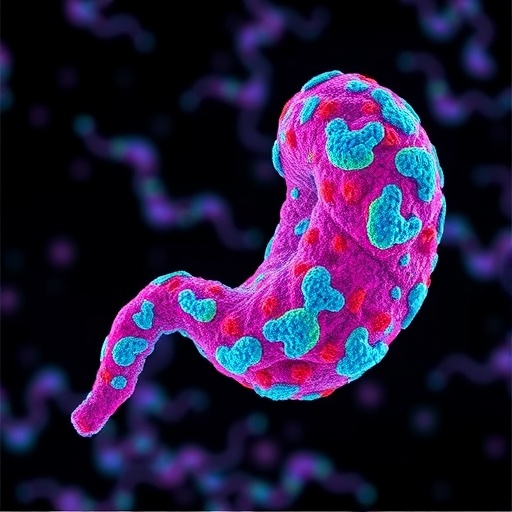In the relentless battle against pancreatic cancer, one of the most lethal malignancies worldwide, treatment resistance and systemic metastasis remain formidable obstacles. Recent advances have illuminated the complex genomic and cellular landscapes of this disease, yet the spatial and transcriptomic heterogeneity that drive therapeutic failure and metastatic progression have been less explored. A groundbreaking study published in Nature by Pei et al. dives deep into the spatial transcriptomic architecture of metastatic pancreatic cancer, unraveling the intricate lineage plasticity and tumor microenvironmental dynamics that underpin treatment-refractory disease.
Pancreatic ductal adenocarcinoma (PDAC) is notorious for its aggressive course and poor prognosis, with most patients succumbing not to the primary tumor burden but rather to systemic spread. While previous research has characterized the molecular subtypes of PDAC and their variable therapeutic vulnerabilities, spatial context within primary and metastatic lesions remained elusive. By employing state-of-the-art spatial transcriptomics on an unprecedented collection of 55 tumor samples from 13 patients, the study maps cellular states and clonal relationships across various metastatic sites, including liver, lung, and peritoneum.
The researchers leveraged rapid autopsy specimens, a resource that permitted a comprehensive survey of both primary tumors and distant metastatic lesions within the same individual. This approach revealed profound shifts in cancer-cell transcriptomic states as tumors disseminate. Notably, distinct lineage states were found to dominate in organ-specific metastases, with the liver and lung harboring markedly different cellular compositions even within the same patient. Such intra-patient heterogeneity underscores the adaptive plasticity of pancreatic cancer cells as they colonize diverse tissue microenvironments.
Crucially, the study constructed phylogenetic trees derived from inferred copy number variations, shedding light on how tumor clones evolve and spread within a single patient. These trees illustrated diverse evolutionary trajectories, highlighting that clonal dissemination is not unidirectional or uniform but rather patient-specific and multifaceted. The ability to map these clonal architectures in spatial context provides essential insights into metastatic seeding patterns and potential vulnerabilities.
Within each metastatic site, multiple tumor lineage states co-existed rather than one dominant clone sweeping through the tissue. Moreover, simultaneous metastatic foci with distinct lineage profiles were observed within the same organ, challenging the traditional view of metastases as monoclonal. This mosaicism reflects both the evolutionary complexity of PDAC and the dynamic interactions between cancer cells and their microenvironment.
The tumor microenvironment (TME) plays a pivotal role in modulating cancer progression and therapy response. By integrating transcriptomic data with spatial information, Pei et al. identified compelling correlations between cancer cell lineage states and features of the surrounding TME. For example, the aggressive basal-like cancer cells predominantly localized with myofibroblastic cancer-associated fibroblasts (myCAFs) expressing transforming growth factor-beta 1 (TGFB1). This spatial proximity was absent in classical or intermediate cancer cell states, indicating a lineage-specific crosstalk that potentially drives more aggressive biology.
Validation via orthogonal methods—including patient-derived organoids and cross-species analysis in mouse models—strengthened these findings, underscoring their biological relevance and reproducibility. Such cross-validation highlights the translational potential of targeting these lineage-specific tumor-stroma interactions in clinical settings.
Interestingly, basal-like cancer cells associated with myCAFs correlated with an exclusion of plasma cells—key components of humoral immunity—from the tumor milieu. Neighboring cell analyses revealed that CXCR4–CXCL12 chemokine signaling pathways may mediate this immune exclusion, unveiling a new axis of immune evasion in metastatic pancreatic cancer. Targeting this signaling axis could reinvigorate immune infiltration and enhance therapeutic efficacy.
The spatially resolved transcriptomic maps also uncover a rich tapestry of cell states and immune contextures, emphasizing the necessity of considering spatial heterogeneity when designing targeted therapies. Tumor lineage plasticity is not merely a snapshot phenomenon but a dynamic process shaped by microenvironmental cues and evolutionary pressures.
By integratively profiling both the genomic and microenvironmental landscapes at high spatial resolution, this study provides a blueprint for understanding how transcriptional plasticity governs metastatic dissemination and immune interactions in PDAC. These insights hold promise for devising novel combination therapies that disrupt key niche interactions and overcome treatment resistance.
The implications of this work extend beyond pancreatic cancer, as spatial transcriptomics can be applied to other refractory metastatic malignancies where lineage heterogeneity and microenvironmental dynamics remain poorly understood. It heralds a new era in cancer research, where spatial context is harnessed to decode tumor complexity and inform precision medicine.
In sum, the meticulous spatial mapping of transcriptomic states across the metastatic spectrum reveals that pancreatic cancer progression is orchestrated by a choreography of tumor cell plasticity, clonal evolution, and niche-specific microenvironmental adaptations. This multidimensional understanding paves the way for innovative therapeutic strategies aimed at dismantling metastatic reservoirs and improving outcomes in this devastating disease.
Subject of Research: Spatial transcriptomic mapping of lineage plasticity and tumor microenvironmental heterogeneity in metastatic pancreatic cancer.
Article Title: Spatial mapping of transcriptomic plasticity in metastatic pancreatic cancer.
Article References:
Pei, G., Min, J., Rajapakshe, K.I. et al. Spatial mapping of transcriptomic plasticity in metastatic pancreatic cancer. Nature (2025). https://doi.org/10.1038/s41586-025-08927-x
Image Credits: AI Generated




